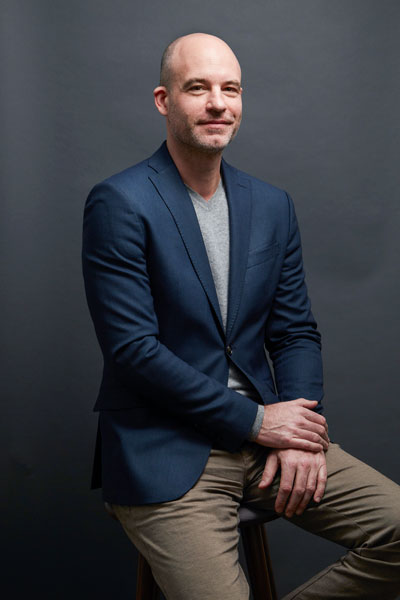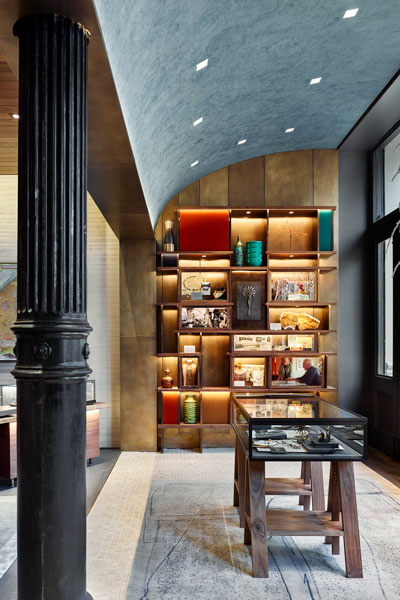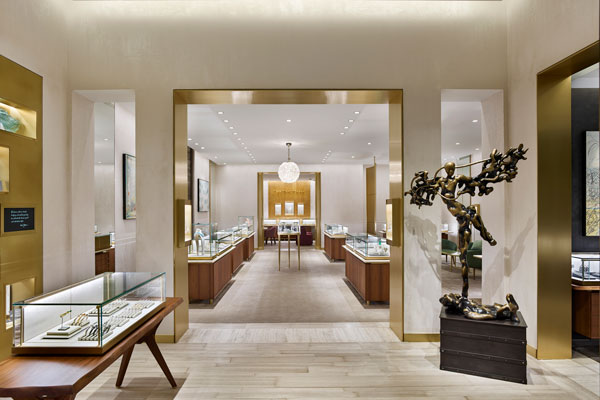
One of Laurent Charlet’s earliest memories is helping to revitalize the warm-gray masonry of a few humble stone structures alongside his father in the south of France.
“I had the good fortune of having parents who had a piece of land there with a couple of old stone ruins on it,” he says. “My father decided to rebuild them himself, so many of my childhood memories are of my father building things. As soon as I was of age, I started helping out, and I became more and more involved in the actual building and making of things. I think those experiences had a deep impact on me eventually becoming an architect.”
Today, Charlet channels those early experiences as senior director of architecture and interiors for New York-based luxury jewelry designer and retailer
David Yurman.
Along with his team, Laurent Charlet’s task is to bring every facet of the iconic jewelry brand to life by designing, planning, implementing, and remodeling the brand’s 32 retail boutiques across the globe as well as the company’s corporate facilities and the occasional special event.
“I’m involved in all projects in which the brand manifests its presence in three dimensions, in the real world,” says Charlet, who was born in Switzerland and earned his masters of architecture from the esteemed École Polytechnique Fédérale de Lausanne.
“The Yurmans have worked very hard to ensure that their values were embodied in their stores and corporate facilities,” he adds. “It’s our duty to make sure their sensibilities and personal affinities translate into the 360-degree environments we build for the brand. We want our environments to speak to who the Yurmans are and what their journey from art to jewelry has been.”
Originally a sculptor and a painter, free-spirited founders David and Sybil Yurman met in New York City and established the designer jewelry brand after a gallerist noticed the remarkable sculptural craftsmanship of a necklace David had made for Sybil as a gift.
From there, the Yurmans set out applying their natural eyes for art to the world of bespoke retail. “Craft is really the foundation this company was built upon—the craft of two artists—so it’s really important to bring nods to their techniques and the materials that they originally used in their art into the environments associated with the brand,” Charlet says.

As artists, the Yurmans frequently use organic materials such as wood and naturally textured metals in their works. Naturally, these elements also surface in their jewelry designs. The Yurmans’ son Evan, who designs for the company as well, also has a talent for using raw, almost industrial materials, which, Charlet says, might not be acknowledged by other jewelry brands as noble enough to be worthy of consideration.
“He’ll take these materials and reveal their natural beauty by working them using techniques maybe not even traditionally associated with them,” Charlet says. “It’s about acknowledging and admiring the little accidents that nature makes along the way, working with them, and learning to enjoy them.”
In turn, Laurent Charlet ensures natural materials such as stone, wood, metal, and leather are ever-present within the stylishly sophisticated interiors of the stores.
And, staying true to the nature of these materials is a core value, too. “If something is meant to look like concrete, then we’ll build it out of concrete,” Charlet says. “If we want a piece of wood to look like it was just sliced from a tree, then we’ll use real live-edge American walnut rather than try to sculpt the edge of a reconstituted slab of wood.”
“We often also refer to Mr. Yurman’s sculptures and Mrs. Yurman’s paintings when creating color palettes for the stores, again because their art is at the core of the values of this company,” Charlet adds. “Looking at their work is always a great inspiration.”
Additionally, these material touchstones provide unseen benefits for the clientele. “We don’t want the spaces to command a behavior from the customer,” Charlet says. “We really want them to feel comfortable and at ease. In addition to referencing the Yurmans’ work materials, using relaxed and relatively common materials makes the stores feel approachable, relaxed, and less intimidating than other brands in luxury retail. I think that artistry is something that separates us from the competition.”

The physical characteristics of a boutique’s location also come into play. “We use stone on a lot of our façades, but we don’t go around slapping the same thing on every storefront,” Charlet says. “Our position is that we should try to think about what a particular stone would feel like if we were building store in Hawaii, Chicago, or Florida, so we choose different stones in a variety of shapes and textures in order to connect the store with the geographical area in which it’s located.”
Charlet and his team also recently started to imbue the boutiques with unique and tasteful vernacular elements from the regions in which the stores are located. “Last year, we commissioned plaster artisans to stencil floral patterns on a white-gold, leafed panel in every store, and we subtly used each state’s flower as the motif that we superimposed onto these panels.”
His team further connects the David Yurman culture to its customer base by using heritage walls, which are curio shelves artfully showcasing the Yurmans’ early work and significant jewelry pieces.
The vast majority of customers may not even notice such small, symbolic details, Charlet says, but these flourishes all combine to create a vital point of relation between the old and the new as well as the brand and the customer.
“We constantly walk a fine line between creativity and the adherence to certain iconic principles,” Charlet explains. “We look at what we’ve done in the past to remind us of who we are and where our successes were, but we also insert elements into each store to join our company values with these specific customers in a certain specific location.”
“How the brand manifests in the real world should truly be a faithful representation of the brand’s values across all channels,” Charlet adds. “This is a company that was created by two people who wanted to find a way to make a living designing and creating beautiful things that they loved. It’s about that rather than simply trying to make a fortune and conquer the world. That was never the plan.”
Photos: Jeffrey Totaro, Gary Petersen
The art of Italian carpentry at the service of contemporary interior design.
Effearredi is a reference point for international architecture and interior design firms to give shape to exclusive and fully custom-made furniture, prioritizing high quality and attention to each detail at every level.


